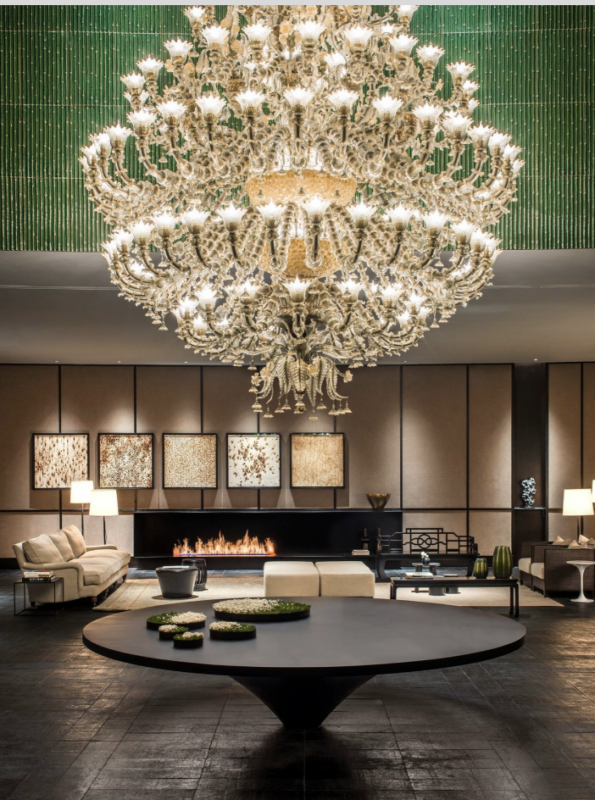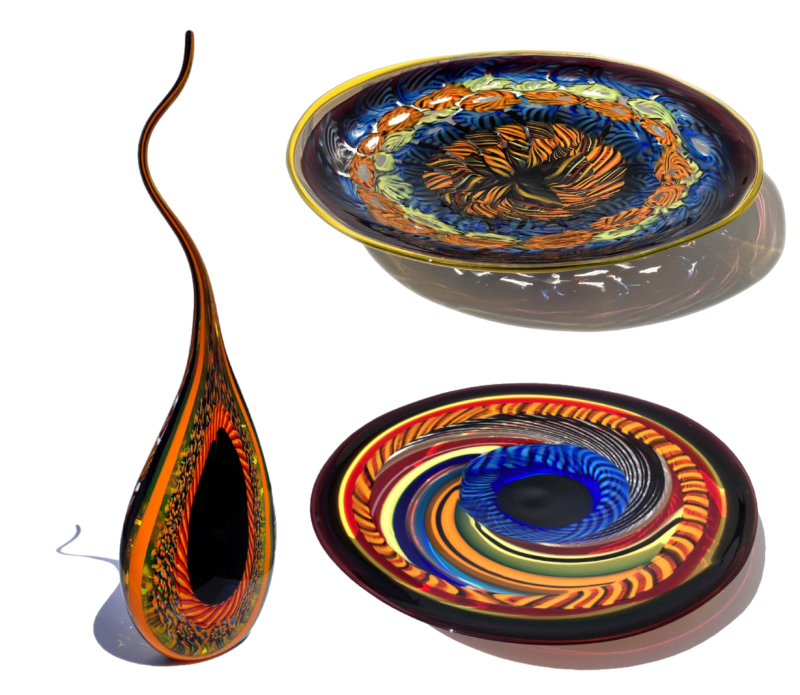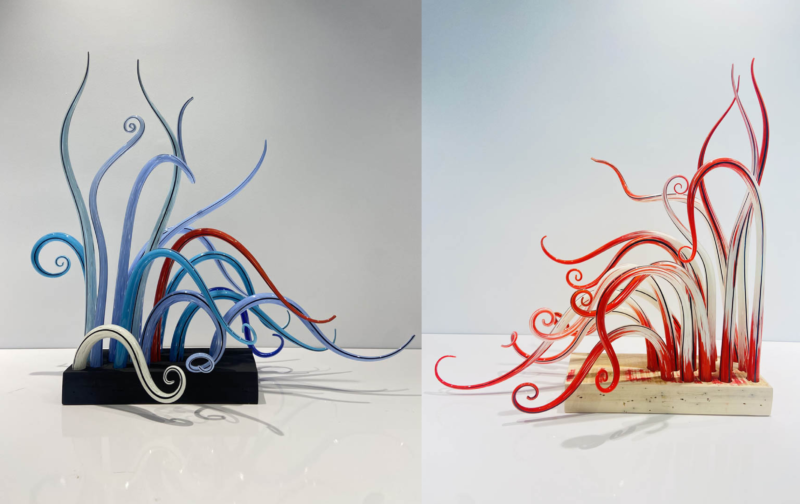Fabiano Zanchi is a Murano glass artist from a family of Venetian glass blowers, who have been passing the craft down from generation to generation. He creates the highly valued Ca' Rezzonico chandeliers, glassware, and art, carefully preserving the centuries-old tradition.
Fine Art Shippers spoke with him about the art of Murano glass blowing, his life-changing experiences in China, and his famous chandelier, which has been named one of the 12 reasons to visit Shanghai.
Artist Talk: Fabiano Zanchi on the Ancient Art of Glassmaking
What inspired you to follow in your father's footsteps and take up glassmaking? Fabiano Zanchi: Growing up in a family that has been making glassware for generations, it felt normal for me to be surrounded by this craft. It was always there since I was born. I remember my mom taking me to the studio as a kid, it felt like magic. The colors and the process of firing captivated me. I started working with glass when I was about 14 or 15, and my dad began teaching me how to make Venetian chandeliers.
So initially you specialized in chandeliers, right? Yes, I grew up as a chandelier maker and continued making chandeliers until about ten or eight years ago when I began exploring new forms. Now, 80 percent of my production consists of sculptures, vases, and various forms of art. Could you tell us more about the chandeliers you and your family make? They are called Ca' Rezzonico chandeliers, a renowned model of Venetian chandelier created by Giuseppe Briatti in the 17th century for the Ca' Rezzonico family. The original can still be seen in the Ca' Rezzonico palace in Venice today. Craftsmen who make them are very rare, which is why I want to preserve this tradition.  Regarding the glass itself—its quality, composition, and the way it's made—is there a difference between your techniques and those used to make other Murano glass objects? The composition of the glass remains the same, it's just the technique that differs. Over the years, faster techniques were developed to increase production, but this reduced the quality of the pieces. I use the traditional technique. Do you work alone, or do you have a team that helps you with some parts of the process? When I started working for my family company, we had 25 highly skilled glassblowers in Murano, as we were also producing affordable, everyday lighting. Today, our team is much smaller, with just five people in the hot shop, including my dad, who is still blowing glass at 65. He can't stop — it's a part of him, just as it is for me. We joke that we'll probably die in the hot shop one day. We are all passionate about what we do and take pride in producing the finest Murano glass. In 2010, you left Murano and went traveling first to Canada and then Asia. What prompted you to do so? My first experience outside of Italy was in 2010 when I went to Canada. I spent three months in Niagara Falls, blowing glass in a gallery on Queen Street, making traditional Venetian chandeliers. Meanwhile, my father started collaborating with a large Chinese lighting company that began purchasing a lot of our products. They asked if I was interested in producing for them in China to help avoid shipping costs. Being young, newly married, and without kids, I decided to give it a try. I moved to China for five years, blowing glass for them.
Regarding the glass itself—its quality, composition, and the way it's made—is there a difference between your techniques and those used to make other Murano glass objects? The composition of the glass remains the same, it's just the technique that differs. Over the years, faster techniques were developed to increase production, but this reduced the quality of the pieces. I use the traditional technique. Do you work alone, or do you have a team that helps you with some parts of the process? When I started working for my family company, we had 25 highly skilled glassblowers in Murano, as we were also producing affordable, everyday lighting. Today, our team is much smaller, with just five people in the hot shop, including my dad, who is still blowing glass at 65. He can't stop — it's a part of him, just as it is for me. We joke that we'll probably die in the hot shop one day. We are all passionate about what we do and take pride in producing the finest Murano glass. In 2010, you left Murano and went traveling first to Canada and then Asia. What prompted you to do so? My first experience outside of Italy was in 2010 when I went to Canada. I spent three months in Niagara Falls, blowing glass in a gallery on Queen Street, making traditional Venetian chandeliers. Meanwhile, my father started collaborating with a large Chinese lighting company that began purchasing a lot of our products. They asked if I was interested in producing for them in China to help avoid shipping costs. Being young, newly married, and without kids, I decided to give it a try. I moved to China for five years, blowing glass for them. 
How did your experiences in China influence you?
This experience changed me a lot and greatly influenced how I perceive glass. I visited many studios and saw people shaping glass using just a piece of paper instead of the specialized tools I was used to. I was impressed by their skill. In Italy, we have proper tools for certain techniques, but these people were replicating our work without them. This made me realize that if you are skilled, you can work with almost anything. I pushed myself to try working without Murano tools, which gave me even more control over the material. As a life experience, it changed my entire life. At that time, I couldn't speak English, and I learned it while in China. I met friends from all over the world, and China opened doors to the entire world for me. Do you make sketches for your chandeliers and artworks? Yes, I do. However, sometimes I enjoy improvising with the glass. I start mixing colors and see what I end up with. In your sculptures and dishes, how much do you use traditional Murano patterns, and to what extent do you introduce your own designs? It's a process you create in the moment. First, you prepare a lot of colored canes, which can take a couple of days. Then, you chop them into various lengths — some look like sushi with patterns inside. Next, you lay them out on a plate to design the pattern. Once the pattern is ready, you put the plate back in the furnace to melt it, then roll it onto a blowpipe and start blowing to shape it. When making these patterns, I prefer to do it randomly, as long as the colors match, rather than following any specific design.  I’ve created your own Glass Academy. Could you briefly tell us about it? The Glass Academy is still one of my dreams, and I'm actively working on it. I've expanded my studio and bought a property to house the academy. However, the bureaucracy in Italy is a challenge, so it's taking some time to make it happen. I truly love teaching and have developed a method that allows people to learn quickly. I want to give everyone the chance to try and make their own Murano glass piece, even if it's just for one day. Your website features logos of numerous famous hotels. What does your collaboration with them involve? I am working with Light Sculpture Murano, an Italian design company based in Bangkok. Together, we have completed numerous five-star hotel projects in Asia alongside the renowned award-winning architect Francesco Cappuccio. Our process involves receiving renderings of spaces like lobbies or ballrooms, then creating the project as a team. One of my chandeliers, which I consider my masterpiece and one of the largest projects I've ever done, is in the Middle House Hotel in Shanghai. I’m proud to say it has received wide professional recognition and has even been featured as one of the 12 reasons to visit Shanghai.
I’ve created your own Glass Academy. Could you briefly tell us about it? The Glass Academy is still one of my dreams, and I'm actively working on it. I've expanded my studio and bought a property to house the academy. However, the bureaucracy in Italy is a challenge, so it's taking some time to make it happen. I truly love teaching and have developed a method that allows people to learn quickly. I want to give everyone the chance to try and make their own Murano glass piece, even if it's just for one day. Your website features logos of numerous famous hotels. What does your collaboration with them involve? I am working with Light Sculpture Murano, an Italian design company based in Bangkok. Together, we have completed numerous five-star hotel projects in Asia alongside the renowned award-winning architect Francesco Cappuccio. Our process involves receiving renderings of spaces like lobbies or ballrooms, then creating the project as a team. One of my chandeliers, which I consider my masterpiece and one of the largest projects I've ever done, is in the Middle House Hotel in Shanghai. I’m proud to say it has received wide professional recognition and has even been featured as one of the 12 reasons to visit Shanghai.
Interview by Inna Logunova Photo courtesy of Fabiano Zanchi
